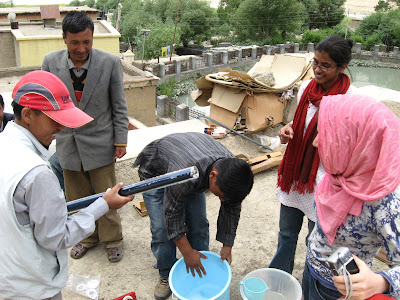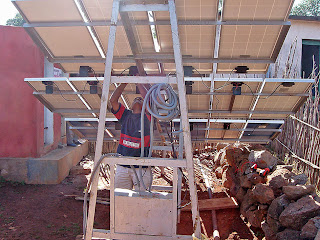On July 28th Aurore technicians Ramesh and Norbu went to Mamallapuram to install the first of our new pressurized Evacuated Tube Collector (ETC) solar water heaters at Hotel Radha, situated near the famous Pancha Rathas.
The new ETC system can handle mains pressures of up to 4 bar, as opposed to only 0.4 bar for the normal ETCs.
The 240 lpd (liters per day) system is on trail and if proven successful, Hotel Radha is going to install additional systems.

Since its inception in 1984, Aurore has installed standard as well as customized renewable energy systems all over India, often in remote locations. Below is an (incomplete) overview of our work so far.
Wednesday, August 6, 2008
Friday, July 11, 2008
Reducing the burden - Solar pumping in Melghat

Maitri is a Pune-based NGO working with local communities in the remote Melghat region of Maharashtra state, close to the border with Madhya Pradesh.
In one of the villages, Ruipathar, the women had to carry all the water they need for running their household (except laundry) up the hill, usually 2 or 3 times a day.



Maitri first contacted Aurore India in March 2008 to inquire about a solar pumping system for Ruipathar village in Melghat. Rishi went for an assessment to Melghat in April, and subsequently Maitri managed to raise the funds to implement this project.
The solar pumping system was designed to pump water from a borewell some 50 m at the bottom of the hill to a tank right in the centre of the village.
An Aurore India team, consisting of Rajesh, Manikandan, Nitin and Jos arrived in Melghat on July 10th, and immediately started the work.
The villagers had already dug most of the long trench from the borewell to the tank.
The best location for the solar panels was agreed upon with the villagers and work the casting of the foundations for the manual trackers started.
On day 2 the HDPE water pipe was unrolled, connected to the submersible pump and lowered into the borehole.


On the final day of installation (day 3) the solar panels were mounted onto the trackers and wired up to supply DC current to the pump.
The pump was switched ON and water started to flow into the tank. You should have seen the faces of the villagers! :-)


We stayed on for another day to make sure the system was pumping fine and help the local plumber with putting in the distribution lines to the tap-stands.
At the end of the day the team could relax and prepare for their return to Auroville

After all the excitement of the past days village life returned to normal, with the exception that women carrying water on their heads up the hill will become more of a rarity in Raipathar village from now onwards.

Tuesday, July 1, 2008
ETCs in the cold
Not long ago Aurore India was contacted by EcoSphere Spiti who were interested to introduce renewable energy technologies in beautiful Spiti Valley in Himachal Pradesh.

Spiti has the same cold and dry climate as Ladakh and it was decided to see whether our ETC solar water heaters could survive in this harsh climate during the cold winters, where temperatures drop to minus 30 degrees Celcius, and still provide useful quantities of hot water.
2 ETC with slightly thicker tank insulation (60 mm instead of 50 mm) were shipped to Kaza in June, the main town in Spiti Valley, where EcoSphere has its office, and Jos went there to help with the installation and give a full training on the systems.
(at the same time 2 more systems were shipped to Leh, Ladakh, for a similar trial there at a guesthouse).
In Kaza one of the ETCs was installed at the EcoSphere office roof during an on-the-job training session. Everybody helped out and learned, and lots of photographs were taken.

 The next day we installed the second system at an old people's home in Ki village, which is run by Buddhist nuns. This time the system was installed by only the EcoSphere co-workers and they did a perfect job!
The next day we installed the second system at an old people's home in Ki village, which is run by Buddhist nuns. This time the system was installed by only the EcoSphere co-workers and they did a perfect job!

 Now the experimenting starts and we're looking forward to see how the ETCs will perform in both Spiti and Leh over the coming winter.
Now the experimenting starts and we're looking forward to see how the ETCs will perform in both Spiti and Leh over the coming winter.
One important lessons learned on this project was that by transporting the glass evacuated tubes vertically, we can avoid a lot of breakage on the way.


On the 10 hour trip in a pickup truck from Manali to Kaza, on very rough roads, not a single tube broke! Vertical makes all the difference.
All in all a job well done, and the head-nun of the old-people's home was very happy with their new solar water heater.


Spiti has the same cold and dry climate as Ladakh and it was decided to see whether our ETC solar water heaters could survive in this harsh climate during the cold winters, where temperatures drop to minus 30 degrees Celcius, and still provide useful quantities of hot water.
2 ETC with slightly thicker tank insulation (60 mm instead of 50 mm) were shipped to Kaza in June, the main town in Spiti Valley, where EcoSphere has its office, and Jos went there to help with the installation and give a full training on the systems.
(at the same time 2 more systems were shipped to Leh, Ladakh, for a similar trial there at a guesthouse).
In Kaza one of the ETCs was installed at the EcoSphere office roof during an on-the-job training session. Everybody helped out and learned, and lots of photographs were taken.

 The next day we installed the second system at an old people's home in Ki village, which is run by Buddhist nuns. This time the system was installed by only the EcoSphere co-workers and they did a perfect job!
The next day we installed the second system at an old people's home in Ki village, which is run by Buddhist nuns. This time the system was installed by only the EcoSphere co-workers and they did a perfect job!
 Now the experimenting starts and we're looking forward to see how the ETCs will perform in both Spiti and Leh over the coming winter.
Now the experimenting starts and we're looking forward to see how the ETCs will perform in both Spiti and Leh over the coming winter.One important lessons learned on this project was that by transporting the glass evacuated tubes vertically, we can avoid a lot of breakage on the way.


On the 10 hour trip in a pickup truck from Manali to Kaza, on very rough roads, not a single tube broke! Vertical makes all the difference.
All in all a job well done, and the head-nun of the old-people's home was very happy with their new solar water heater.

Friday, June 20, 2008
Sani clinic, Zanskar, Ladakh
It was still relatively quiet in Ladakh when the AuroRE team headed up there this year for the installation of a 1,050 Wp solar PV system at a remote clinic in Zanskar valley in the second week of June.
Rishi, Hemant and Jos all met up in Delhi where a jeep was loaded with the solar panels, sealed maintenance-free batteries, the aluminium mounting structure and boxes with accessory cables, charge controller, inverter, etc.
This was the 6th consecutive year that Aurore was doing an installation in Ladakh, one of the most remote regions of India, high up in the Himalayas.


The 5 day journey in the jeep took us from Delhi via Manali, Leh and Kargil to our end-destination, Sani, 10 km from Padum, Zanskar valley's main town.
There Dr Rainer Lezius (Germany) has initiated a project to preserve traditional Ladakhi herbal medicine by building a small clinic-cum-community centre.
Raising funds through Fördervereins Sani Zanskar e.V. made it possible to build the small building, which was completed last year.
What was missing though was a reliable source of electrical power for lighting the rooms, as well as provide power for laptop computers and other small electrical devices.
Rainer contacted Aurore and a suitable solar PV system was designed and prepared in Auroville before being shipped to Sani village.


One of the monks of the local Sani monastery came to have a look and gave the solar panels his blessing! :-)

Rishi, Hemant and Jos all met up in Delhi where a jeep was loaded with the solar panels, sealed maintenance-free batteries, the aluminium mounting structure and boxes with accessory cables, charge controller, inverter, etc.
This was the 6th consecutive year that Aurore was doing an installation in Ladakh, one of the most remote regions of India, high up in the Himalayas.


The 5 day journey in the jeep took us from Delhi via Manali, Leh and Kargil to our end-destination, Sani, 10 km from Padum, Zanskar valley's main town.
There Dr Rainer Lezius (Germany) has initiated a project to preserve traditional Ladakhi herbal medicine by building a small clinic-cum-community centre.
Raising funds through Fördervereins Sani Zanskar e.V. made it possible to build the small building, which was completed last year.
What was missing though was a reliable source of electrical power for lighting the rooms, as well as provide power for laptop computers and other small electrical devices.
Rainer contacted Aurore and a suitable solar PV system was designed and prepared in Auroville before being shipped to Sani village.


One of the monks of the local Sani monastery came to have a look and gave the solar panels his blessing! :-)

Saturday, June 14, 2008
Solar power packs - Orissa tribal settlements

Our partners, Gram Vikas, a reputed NGO in Orissa, are dedicated to bringing clean water and power to the grassroots. Gira is a tribal settlement near Gajapati in Orissa, where drinking water needs were, until recently, being met physically with each household having to fetch up to 40 lts. of water (and not very clean) everyday over a long distance, from a stream a few kilometres away.
Today this scenario no longer exists in Gira. It has been replaced with a solar water pumping and lighting system. Gram Vikas echoes the thoughts of the villagers of Gira when declaring that this has brought ease along with dignity into the lives of these poor tribals.

A fortunate spin-off from this is the fact of kerosene being replaced as primary household lighting in these parts. They realise that it is a plus for their health and savings.
Gram Vikas asserts the very real benefits of solar powered systems for lighting and water pumping in remote parts of Orissa (a template for the rest of India!), where clean water is scarce and electricity even more so. An intermediary like solar power can best fill this gap adding immeasurably to the quality of rural life.
Aurore supplied the system to Gram Vikas in June of this year. It’s installed capacity is 1350 W (18 panels of 75W each). The pump is a Grundfos SQF 3A-10 with a flow rate of 3000ltr/Hr.

The panels power the pump directly during the day while a battery bank provides power for home lighting at night. Aurore trained a small group of villagers on basic system care. We are still consulted for major interventions if required and our staff pays periodic visits to our rural projects to provide enhanced system maintenance tips and training to end users.
Subscribe to:
Posts (Atom)